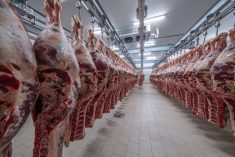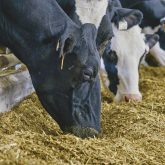A major U.S. hog and pork company’s influential decision to phase out the use of gestation stalls at its sow farms has run up against the hog industry’s current cash crunch.
Smithfield Foods, the world’s largest producer and processor of pork, announced in its 2009 annual report Wednesday that it no longer expects to complete that phase-out within 10 years as previously planned.
The company in 2008 pegged the total cost of a company-wide transition to group sow housing at US$300 million, and stuck to that figure in this week’s outlook.
“Due to recent significant operating losses incurred by our hog production segment, we have delayed capital expenditures for the program such that we no longer expect to complete the phase-out within 10 years of the original announcement,” the company said.
Smithfield’s original announcement in January 2007 was billed as a “landmark decision” in the company’s animal management. Wednesday’s announcement had been telegraphed a year ago in the Virginia-based company’s 2008 annual report. Referring to the January 2007 announcement of the phase-out, the company then said “we (Smithfield) anticipate this will occur over the next 12 to 13 years.”
The transition continues, however, with preliminary work underway to determine the “best approach” at each of its breeding farms, the company said Wednesday.
“Extensive retrofits”
Some Smithfield farms will require “extensive retrofits and reconfiguration,” the company said, and many of its farms may also require new permits from state agencies to make any significant changes.
Group housing conversions, however, have already taken place at two existing Smithfield farms in North Carolina and Colorado and at a newly built facility at Milford, Utah.
The facility at Milford, about 270 km southwest of Provo, includes two new 5,000-hog housing sites where sows have access to individual stalls to eat, drink, and rest, but can also move into a more open pen area, the company said Wednesday.
Smithfield on June 16 posted a net loss of US$190.3 million on $12.5 billion in sales for the year ending May 3, down from a $128.9 million loss on $11.4 billion in sales in the year-earlier period (all figures US$).
“I can summarize the quarter and I can summarize the year very, very succinctly in saying that we have a hog production issue,” Smithfield CEO Larry Pope said in a transcribed conference call with industry analysts.
“The part of the business that has carried this organization for many years has flipped on its head as a result of sharply increased raising costs last year that we’ve talked about many, many times and those are continuing into the fourth quarter, just as we had told you they would be, and that raised our cost on a comparable basis from $54 a hundredweight to $63 a hundredweight.”
Citing the demands on feed grains from the ethanol sector and increased feed costs, Pope said, “it doesn’t take a rocket scientist to figure out that the issue is grain cost and that has got to be resolved one of two ways. Either grains have got to moderate or the live hog market has got to move up and be transferred through in terms of higher meat prices to consumers.”
— The “Editors’ Picks” feature will highlight eyebrow-raising and unusual-yet-true news from the world of farming, as gleaned from various sources by the editorial staff of the Farm Business Communications division.
















